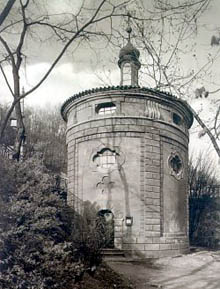
The Chapel of Mary Magdalene had to give way to construction, but it survived
 |
The circular single-storey early Baroque chapel was built in 1635 on the former monastery vineyard under Letná by the provost of the Cyriak monastery, which existed on the opposite bank of the Vltava River at today’s Curie Square. The Chapel of St. Mary Magdalene was originally located in close proximity to the Svatopluk Čech bridge. The monument with a rich history was initially meant to serve swimmers and winemakers; it has been used by the Old Catholic Church for several years now. However, due to road modifications along the embankment and a planned staircase to the enormous Stalin monument, the chapel was threatened with demolition.
In 1956, the structure was therefore moved 30.75 meters upstream. The entire project was designed and carried out by Academician Stanislav Bechyně. It was the first operation of its kind in the republic – and also very technically demanding. The Chapel of St. Mary Magdalene was first reinforced internally with a wooden structure, surrounded by steel rings. It was also underpinned by a reinforced concrete crown. Then it was relocated to a prepared site along a track with rails for transport carts and with the aid of a pushing device and then renovated.
Vineyards and gardens covered the Letná slope up to the left bank of the Vltava River at the beginning of the 17th century. One of the vineyards belonged to the Cross Knights with the Red Heart at the Church of St. Cross Greater. The people of Prague knew the members of this order as White Cross Knights or as Cyriaks, named after their legendary founder. It was Provost Jan Zlatoústý Trembský, the highest representative of the local monastery at the time, who commissioned the chapel's construction. The charming building with a dome, bell tower, small windows, and impressive frescoes was designed by the Italian architect Giovanni Battista de Barrifis.
The history of the Chapel of St. Mary Magdalene is rich. In the final phase of the Thirty Years' War, it was occupied by Swedish troops, who from there fired on Prague students defending the Old Town in 1648. When the situation calmed down, the Cyriaks returned to it. The chapel found itself in an unenviable situation in 1783 when Joseph II abolished it along with the monastery and the Church of St. Cross Greater. The desacralized chapel then served for a long time as a firewood store, and later the director of the nearby Civic Swimming Pool kept goats and pigeons in it. Better times began to dawn for the chapel in 1908 - at that time, the city of Prague acquired it, had it cleaned and repaired, and then lent it to the Old Catholic Church.
The English translation is powered by AI tool. Switch to Czech to view the original text source.
0 comments
add comment










